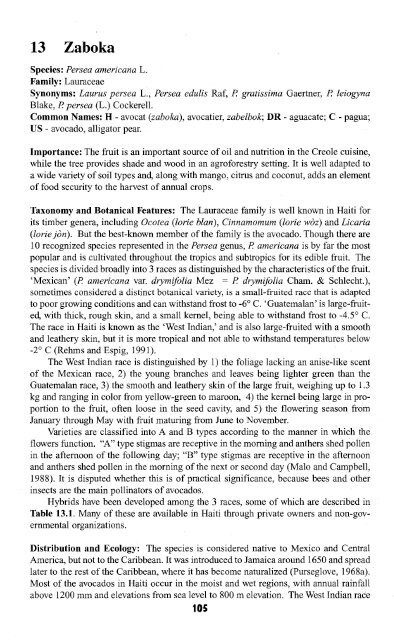Bwa-yo - Société Audubon Haiti
Bwa-yo - Société Audubon Haiti
Bwa-yo - Société Audubon Haiti
Create successful ePaper yourself
Turn your PDF publications into a flip-book with our unique Google optimized e-Paper software.
13 Zaboka<br />
Species: Persea americana L.<br />
Family: Lauraceae<br />
Synonyms: Laurus persea L., Persea edulis Raf, P. gratissima Gaertner, P. leiogyna<br />
Blake, P. persea (L.) Cockerell.<br />
Common Names: H - avocat (zaboka), avocatier, zabelbok; DR - aguacate; C - pagua;<br />
US - avocado, alligator pear.<br />
Importance: The fruit is an important source of oil and nutrition in the Creole cuisine,<br />
while the tree provides shade and wood in an agroforestry setting. It is well adapted to<br />
a wide variety of soil types and, along with mango, citrus and coconut, adds an element<br />
of food security to the harvest of annual crops.<br />
Taxonomy and Botanical Features: The Lauraceae family is well known in <strong>Haiti</strong> for<br />
its timber genera, including Ocotea (lorie blan), Cinnamomum (lorie woz) and Licaria<br />
(lorie jon). But the best-known member ofthe family is the avocado. Though there are<br />
10 recognized species represented in the Persea genus, P americana is by far the most<br />
popular and is cultivated throughout the tropics and subtropics for its ediblefruit. The<br />
species is divided broadly into 3 races as distinguished by the characteristics ofthe fruit.<br />
'Mexican' (P. americana var. drymifolia Mez = P. drymifolia Cham. & Schlecht.),<br />
sometimes considered a distinct botanical variety, is a small-fruited race that is adapted<br />
to poor growing conditions and can withstand frost to _6° C. 'Guatemalan' is large-fruited,<br />
with thick, rough skin, and a small kernel, being able to withstand frost to -4.5° C.<br />
The race in <strong>Haiti</strong> is known as the 'West Indian,' and is also large-fruited with a smooth<br />
and leathery skin, but it is more tropical and not able to withstand temperatures below<br />
_2° C (Rehms and Espig, 1991).<br />
The West Indian race is distinguished by 1) the foliage lacking an anise-like scent<br />
of the Mexican race, 2) the <strong>yo</strong>ung branches and leaves being lighter green than the<br />
Guatemalan race, 3) the smooth and leathery skin ofthe large fruit, weighing up to 1.3<br />
kg and ranging in color from yellow-green to maroon, 4) the kernel being large in proportion<br />
to the fruit, often loose in the seed cavity, and 5) the t10wering season from<br />
January through May with fruit maturing from June to November.<br />
Varieties are classified into A and B types according to the manner in which the<br />
t10wers function. "A" type stigmas are receptive in the morning and anthers shed pollen<br />
in the afternoon of the following day; "B" type stigmas are receptive in the afternoon<br />
and anthers shed pollen in the morning ofthe next or second day (Malo and Campbell,<br />
1988). It is disputed whether this is of practical significance, because bees and other<br />
insects are the main pollinators of avocados.<br />
Hybrids have been developed among the 3 races, some of which are described in<br />
Table 13.1. Many of these are available in <strong>Haiti</strong> through private owners and non-governmentalorganizations.<br />
Distribution and Ecology: The species is considered native to Mexico and Central<br />
America, but not to the Caribbean. It was introduced to Jamaica around 1650 and spread<br />
later to the rest ofthe Caribbean, where it has become naturalized (Purseglove, 1968a).<br />
Most of the avocados in <strong>Haiti</strong> occur in the moist and wet regions, with annual rainfall<br />
above 1200 mm and elevations from sea level to 800 m elevation. The West Indian race<br />
105



